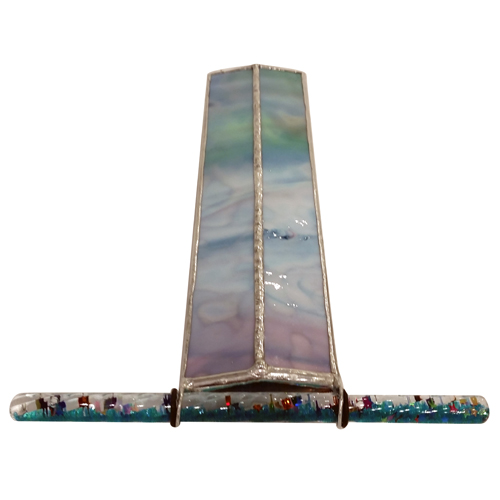 Wheel Kaleidoscopes have one, two, or more wheels which comprise the end-piece. The wheels can be fixed or hollow cylinders, carousels, or turntables and are made of glass, stone, metal filigree, or many other materials arranged in a variety of patterns.
Wheel Kaleidoscopes have one, two, or more wheels which comprise the end-piece. The wheels can be fixed or hollow cylinders, carousels, or turntables and are made of glass, stone, metal filigree, or many other materials arranged in a variety of patterns.
The wheel kaleidoscope pictured at left is "Large Signet Agate-Brass" by artist Jon Greene of Chesnik Scopes (also available in Small, and both sizes are available in Chrome).
Other artists who make wheel kaleidoscopes include: Kaleido Art, Roy Cohen, Steve Failows, Frank Higgins and Sheryl Koch Kaleidoscopes.
 Dry Cell Kaleidoscopes contain colorful pieces that tumble as you turn them. Unlike oil-filled cell kaleidoscopes, when you stop turning the end pieces, the interior pieces stop tumbling. Some people prefer this type, because it allows one to focus on the image for a while, and even take a photo of the image.
Dry Cell Kaleidoscopes contain colorful pieces that tumble as you turn them. Unlike oil-filled cell kaleidoscopes, when you stop turning the end pieces, the interior pieces stop tumbling. Some people prefer this type, because it allows one to focus on the image for a while, and even take a photo of the image.
The dry cell toy kaleidoscope pictured at left is "Curious George," part of our Kaleidoscope Toy collection.
Artists who handcraft dry cell kaleidoscopes include: Karascopes, Koji Yamami, Kathleen Hunt, Frank Higgins and Workingwood.
 Oil-Cell Kaleidoscopes have many moving pieces inside the cell, also called the chamber or object case, which provide the most varied and non-repetitive imagery. There is also more variety in the cell itself: clear, frosted, or etched; recessed, flush, or protruding; and black backdrop, side-lit. By turning the cell, the objects tumble quickly or slowly, depending on the viscosity of the oil. Once you stop turning, the objects continue to drift dreamily, which make them very popular and unexpected.
Oil-Cell Kaleidoscopes have many moving pieces inside the cell, also called the chamber or object case, which provide the most varied and non-repetitive imagery. There is also more variety in the cell itself: clear, frosted, or etched; recessed, flush, or protruding; and black backdrop, side-lit. By turning the cell, the objects tumble quickly or slowly, depending on the viscosity of the oil. Once you stop turning, the objects continue to drift dreamily, which make them very popular and unexpected.
The oil-Cell cell kaleidoscope pictured at left is "Moontide" in Bubinga wood (also available in Maple), by artist Henry Bergeson of Blackfoot Ventures.
Other artists who make oil cell kaleidoscopes include: Chromascopes, KaleidoCompany, Fantasy Glassworks, Kaleidovisions, On Reflection, Kaleidoscope Artistry, Sue Rioux Designs, and Woodland Designs.
 Wand Kaleidoscopes are so named because of the distinctive wand, pioneered in 1990 by WildeWood Creative Products (in collaboration with Cozy Baker). Wand kaleidoscopes are popular because you don't have to do anything. Merely hold it like an hourglass, look through the eyepiece and let gravity do the work for you. One can hold this type of kaleidoscope at an angle to slow down the movement. Twirling the wand will result in even more reflection and excitement.
Wand Kaleidoscopes are so named because of the distinctive wand, pioneered in 1990 by WildeWood Creative Products (in collaboration with Cozy Baker). Wand kaleidoscopes are popular because you don't have to do anything. Merely hold it like an hourglass, look through the eyepiece and let gravity do the work for you. One can hold this type of kaleidoscope at an angle to slow down the movement. Twirling the wand will result in even more reflection and excitement.
The distinctive diamond-shaped wand kaleidoscope pictured at left is "8 inch Yin Yang" (available in many colors and in 4" and 6") by artist David Sugich of Ultimate Reflections.
Other artists who create wand kaleidoscopes include: Kaleido Art, On Reflection, and Sue Rioux Designs.
 Kaleidoscope Jewelry combines the beauty of wearable art with the intricate designs of handcrafted kaleidoscopes. Some of the smallest kaleidoscopes can be found on necklaces or rings. Even with small eyepieces, there is no limit to the images created with these kaleidoscopes.
Kaleidoscope Jewelry combines the beauty of wearable art with the intricate designs of handcrafted kaleidoscopes. Some of the smallest kaleidoscopes can be found on necklaces or rings. Even with small eyepieces, there is no limit to the images created with these kaleidoscopes.
The intricate kaleidoscope pendant pictured at left is "Saturn-Blue Topaz" in sterling silver by artists Deborah & Kevin Healy of Healy Designs.
We invite you to explore our entire kaleidoscope jewelry section. They're "portable Zen"!
 Teleidoscopes have a clear orb on the end that turns everything they are pointed toward into a kaleidoscopic image. With a teleidoscope, the world is your image! If you're looking for a relatively inexpensive handcrafted kaleidoscope, a teleidoscope is a great option because of its simplicity in design. With some, you can even take pictures with a digital camera and turn your friends into kaleidoscopic images.
Teleidoscopes have a clear orb on the end that turns everything they are pointed toward into a kaleidoscopic image. With a teleidoscope, the world is your image! If you're looking for a relatively inexpensive handcrafted kaleidoscope, a teleidoscope is a great option because of its simplicity in design. With some, you can even take pictures with a digital camera and turn your friends into kaleidoscopic images.
Artists who make teleidoscopes include: Blackfoot Ventures, On Reflection, and Wooden Objects.
